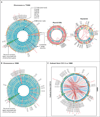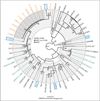Origins of the E. coli strain causing an outbreak of hemolytic-uremic syndrome in Germany
- PMID: 21793740
- PMCID: PMC3168948
- DOI: 10.1056/NEJMoa1106920
Origins of the E. coli strain causing an outbreak of hemolytic-uremic syndrome in Germany
Abstract
Background: A large outbreak of diarrhea and the hemolytic-uremic syndrome caused by an unusual serotype of Shiga-toxin-producing Escherichia coli (O104:H4) began in Germany in May 2011. As of July 22, a large number of cases of diarrhea caused by Shiga-toxin-producing E. coli have been reported--3167 without the hemolytic-uremic syndrome (16 deaths) and 908 with the hemolytic-uremic syndrome (34 deaths)--indicating that this strain is notably more virulent than most of the Shiga-toxin-producing E. coli strains. Preliminary genetic characterization of the outbreak strain suggested that, unlike most of these strains, it should be classified within the enteroaggregative pathotype of E. coli.
Methods: We used third-generation, single-molecule, real-time DNA sequencing to determine the complete genome sequence of the German outbreak strain, as well as the genome sequences of seven diarrhea-associated enteroaggregative E. coli serotype O104:H4 strains from Africa and four enteroaggregative E. coli reference strains belonging to other serotypes. Genomewide comparisons were performed with the use of these enteroaggregative E. coli genomes, as well as those of 40 previously sequenced E. coli isolates.
Results: The enteroaggregative E. coli O104:H4 strains are closely related and form a distinct clade among E. coli and enteroaggregative E. coli strains. However, the genome of the German outbreak strain can be distinguished from those of other O104:H4 strains because it contains a prophage encoding Shiga toxin 2 and a distinct set of additional virulence and antibiotic-resistance factors.
Conclusions: Our findings suggest that horizontal genetic exchange allowed for the emergence of the highly virulent Shiga-toxin-producing enteroaggregative E. coli O104:H4 strain that caused the German outbreak. More broadly, these findings highlight the way in which the plasticity of bacterial genomes facilitates the emergence of new pathogens.
Figures


Comment in
-
Re: origins of the E. coli strain causing an outbreak of hemolytic-uremic syndrome in Germany.J Urol. 2012 Feb;187(2):514-5. doi: 10.1016/j.juro.2011.10.081. Epub 2011 Dec 15. J Urol. 2012. PMID: 22237328 No abstract available.
References
-
- Bielaszewska M, Mellmann A, Zhang W, et al. Characterisation of the Escherichia coli strain associated with an outbreak of haemolytic uraemic syndrome in Germany, 2011: a microbiological study. Lancet Infect Dis. 2011 June 22; (Epub ahead of print) - PubMed
-
- Frank C, Werber D, Cramer JP, et al. Epidemic profile of Shiga-toxin–producing Escherichia coli O104:H4 outbreak in Germany — preliminary report. N Engl J Med. 2011 - PubMed
-
- Scheutz F, Nielsen EM, Frimodt-Moller J, et al. Characteristics of the enteroaggregative Shiga toxin/verotoxinproducing Escherichia coli O104:H4 strain causing the outbreak of haemolytic uraemic syndrome in Germany, May to June 2011. Euro Surveill. 2011;16:pii:19869. - PubMed
Publication types
MeSH terms
Grants and funding
LinkOut - more resources
Full Text Sources
Other Literature Sources
Medical
Molecular Biology Databases
Research Materials
